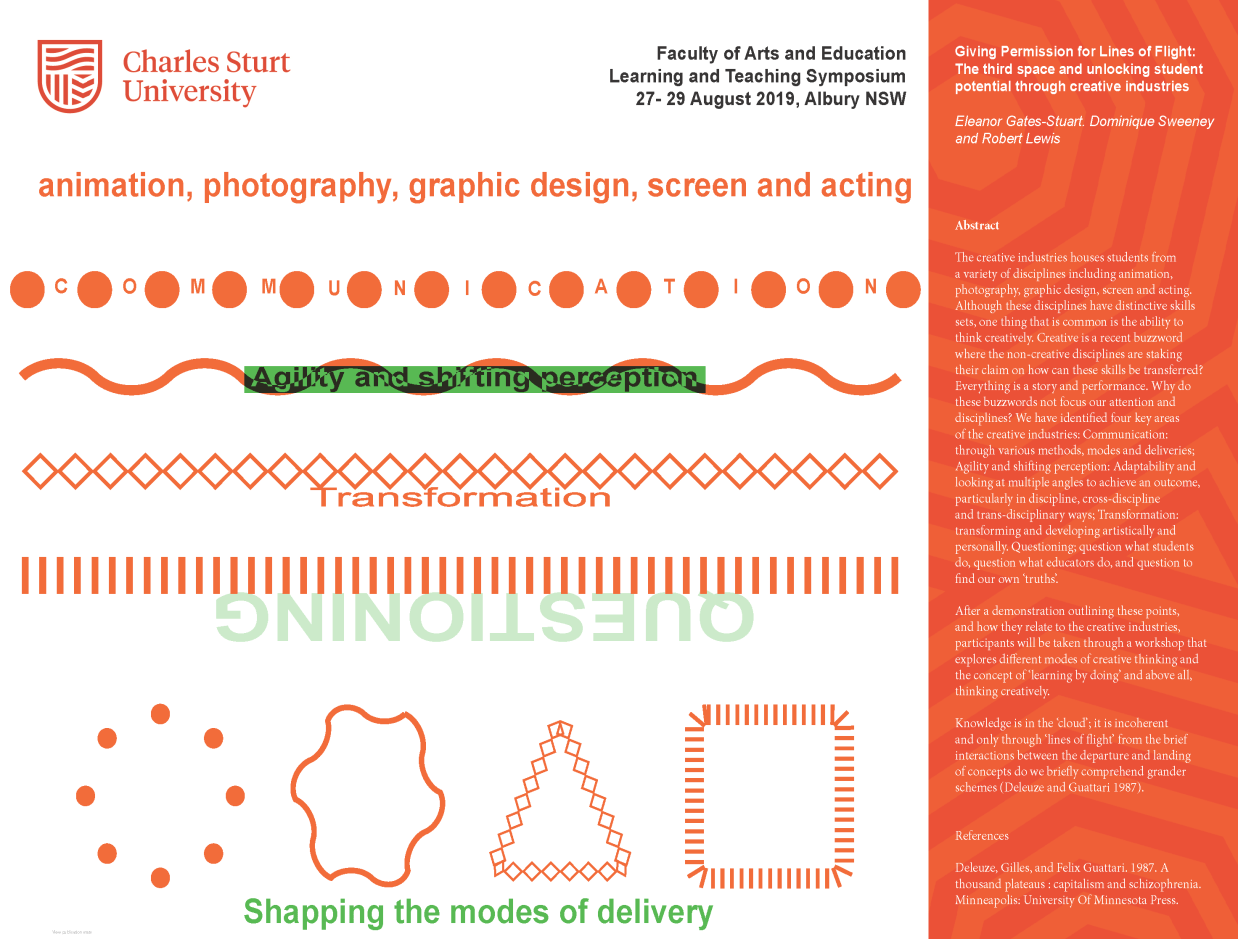Giving Permission for Lines of Flight: The third space and unlocking student potential through creative industries
Charles Sturt University, Faculty of Arts and Education
Learning and Teaching Symposium, 27- 29 August 2019, Albury NSW
Eleanor Gates-Stuart, Dominique Sweeney and Robert Lewis
Abstract
The creative industries houses students from a variety of disciplines including animation, photography, graphic design, screen and acting. Although these disciplines have distinctive skills sets, one thing that is common is the ability to think creatively. Creative is a recent buzzword where the non-creative disciplines are staking their claim on how can these skills be transferred? Everything is a story and performance. Why do these buzzwords not focus our attention and disciplines? We have identified four key areas of the creative industries: Communication: through various methods, modes and deliveries; Agility and shifting perception: Adaptability and looking at multiple angles to achieve an outcome, particularly in discipline, cross-discipline and trans-disciplinary ways; Transformation: transforming and developing artistically and personally. Questioning; question what students do, question what educators do, and question to find our own ‘truths’.
After a demonstration outlining these points, and how they relate to the creative industries, participants will be taken through a workshop that explores different modes of creative thinking and the concept of ‘learning by doing’ and above all, thinking creatively.
Knowledge is in the ‘cloud’; it is incoherent and only through ‘lines of flight’ from the brief interactions between the departure and landing of concepts do we briefly comprehend grander schemes (Deleuze and Guattari 1987).
References
Deleuze, Gilles, and Felix Guattari. 1987. A thousand plateaus : capitalism and schizophrenia.


Professor Eleanor Gates Stuart, Dr Robert Lewis and Dr Dominique Sweeney presented a workshop for the 2019 Learning and Teaching Symposium called: Giving Permission for Lines of Flight: The third space and unlocking student potential through creative industries. The workshop looked into ways in which we can transform learning and teaching spaces by thinking creatively and not being restricted by certain ways of thinking. The idea is that imagination is not restricted to the workshop room with either thoughts within or the physical boundary; the room offers a multiplicity of potentials if it is a space ‘ready to go’. Participants were encouraged to have a transformative shared awareness, and by using activated sensory awareness we transform our worlds through embodied experiential learning.
The workshop comprised of three parts which used enhanced experience through deprivation, for example, focusing on seeing without using your eyes (by using blindfolds) and transforming the physical space without leaving or changing anything in it.
Firstly, participants were blindfolded and given bags of water to feel with each recipient responds with “I wonder…” (for example “I wonder what would happen if I dropped this bag of water?” And so on – take a moment to smell, taste, feel, and listen). This led to the second activity where everyone paired up and were guided through the space and outside the building for up to 5 minutes. This can be as adventurous as is safe eg. under, over, around and through, slow, fast, negotiating smooth and rough terrain. Focus on smell and the feel of the air. Swap over blindfolds outside so that the initial blindfolded person guides the other now blindfolded partner back to the room.
The final activity gave participants an opportunity to imagine the learning environment of the past, present and future by including the space, objects and people in the room. In 5 min, participants were asked to create a world inside this room using the objects the people and our senses or lack of e.g. you could ask us to close our eyes, or just to touch and explore, to smell and remember, to taste and savour so that we use our imaginations to experience a room that is not a school classroom but a carefully sculptured environment.


